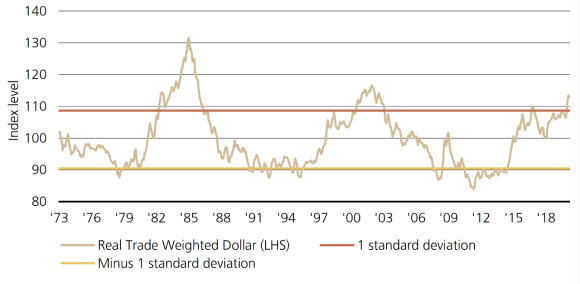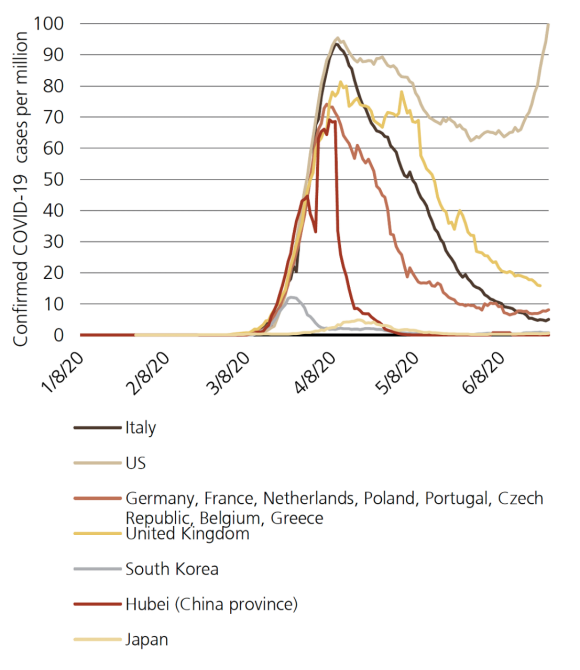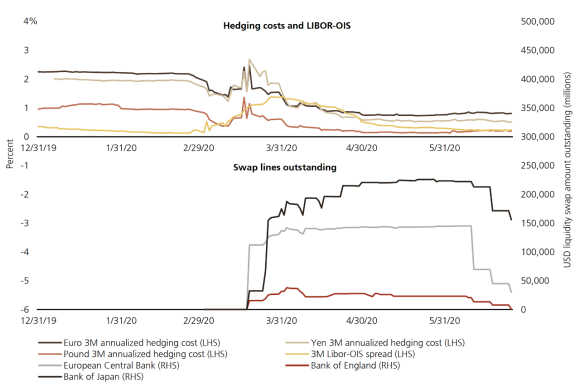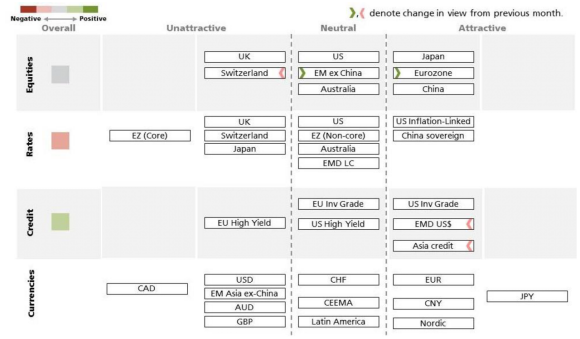Macro Monthly The US dollar’s undoing
The rotation from severe financial stress and recession to economic expansion has profound implications for foreign exchange markets, that investors would do well to recognize.

Highlights
Highlights
- The rotation from severe financial stress and recession to economic expansion has profound implications for foreign exchange markets.
- An early cycle environment is typically associated with US dollar weakness that would play out over at least the coming months.
- Poor US health outcomes relative to peers and the scale of the monetary policy response are eroding the key pillars of the prior bull run: superior relative growth and much higher interest rates.
- The US election should soon assume more prominence as a driver of financial markets, with rising political uncertainty and potential policy changes likely to be negative for the dollar.
- Our call for tactical dollar weakness informs relative value opportunities not only in foreign exchange, but also equities and fixed income.
- Dollar pessimism is tempered by elevated global economic uncertainty and countervailing forces that could limit the magnitude and length of any downdraft.
Exhibit 1: US trade-weighted real dollar at historically elevated valuations
Exhibit 1: US trade-weighted real dollar at historically elevated valuations
Federal Reserve gauge of USD more than one standard deviation above its long-term average

A stampede to safety in financial markets fueled by the spread of the COVID-19 pandemic propelled the real value of the trade-weighted US dollar to its highest in over a decade in March, reaching levels not seen since 2002.
The ensuing US monetary policy and public health response to the crisis are key reasons why we believe March will mark the climax of the US dollar's multi-year run, with further weakness to come. Two pillars of the dollar’s strength – a superior growth outlook and substantial yield premium – have significantly eroded, while the promise of rising politicaluncertainty threatens to amplify USD headwinds over the tactical investment horizon.
Safety first
Among advanced economies, the US is acutely vulnerable to a recovery that comes in fits and starts because of its subpar results in controlling the spread of the virus or instituting effective track and trace measures that would mitigate the impact of regional outbreaks.
Exhibit 2: US virus control is poor vs. most nations
Exhibit 2: US virus control is poor vs. most nations
Confirmed COVID-19 cases per million people, 7-day average (Data are adjusted to align timing of initial peaks in cases by region.)

An absence of widespread shelter-in-place orders may not prevent deteriorating health outcomes from weighing on the US recovery. Localized lockdowns may still occur in areas where hospital capacity is overwhelmed. Consumers may become more cautious and forgo discretionary activities like dining at a restaurant. Data from restaurant reservations app OpenTable for cities which have recently seen a sharp uptick in cases suggest this trend may be taking hold. These regressions in curbing infection rates may also prompt companies to unilaterally close in certain ‘hot spot’ locations, as Apple has done in many southern states.
We expect these dynamics will foster lingering concerns that the US road to recovery will be bumpy compared to nations that have had more success in controlling the virus, such as Germany, South Korea, and Japan. This undercutting of the growth premium previously attached to the US dollar should occur in tandem with a downward adjustment in its value vs. many other currencies.
Peak panic, peak dollar
Macro uncertainty is only barely off the boil, but the demand for greenbacks associated with market turmoil shows to us that the crisis phase is firmly in the rear-view mirror. Other central banks have decreased their swap lines outstanding with the Federal Reserve, signaling that the global scramble for dollars is lessening and can be more easily satisfied through traditional funding markets rather than emergency measures.
An important gauge of credit risk, the three-month Libor-OIS (overnight index swap rates) spread, has normalized to early 2020 levels. In addition, the three-month annualized hedging cost of US dollar exposure relative to the yen, euro, or pound has retreated to multi-year lows. German and Japanese investors have had to take on foreign exchange risk and be long the dollar in order to garner a superior return by investing in 10-year Treasuries compared to local sovereign bonds since Q2 2017 and Q4 2018, respectively. Tumbling hedging costs allow for Treasuries to be bought without this dollar exposure, mitigating a source of support for the currency. FX-hedged 10-year Treasury yields offer roughly 15 basis points of additional yield compared to their Japanese counterparts, and about 30 basis points over German bunds.
Recovery, reversal
The ebbing of peak financial stress was soon followed by high frequency data pointing to a nascent global economic upswing. And since the Plaza Accord of 1985, an agreement to bring down the value of the USD entered into by the then G5 nations – US, UK, West Germany, France and Japan – passing the trough of the business cycle has coincided with weakness in the greenback.
Countercyclical monetary policy lays a foundation for a recovery, thereby encouraging the unwind of long-dollar positions built up during risk-off episodes in markets and offering support for commodity prices, which typically move inversely to the dollar. For reference, the retreat in the Dollar Spot Index and Bloomberg Dollar Spot Index since the March high is currently less than half of the drawdown that came in the months following the conclusion of the GFC-era bear market in global equities.
The convergence of Treasury yields relative to their advanced-economy counterparts amid the Federal Reserve’s descent to the zero lower bound, aggressive asset purchasing program, and potential imposition of yield curve control bolsters the case for dollar weakness at this particular inflection point.
Financial markets reflect US COVID-19 response
The period since US stocks hit their post-pandemic peak on June 8 throws into sharp relief how the deficient American public health response is becoming visible in financial markets.
Equities, on a geographic basis, have diverged from their usual relationships with factors and fixed income. Treasury yields declined by 20 basis points over this span, while value stock benchmarks have lagged their growth peers by roughly 9 percentage points. These two trends tend to be associated with the outperformance of US stocks relative to the rest of the world, since the S&P 500 Index is dominated by mega-cap tech giants more so than other global markets. Growth stocks tend to provide better returns when activity is expected to be meager and borrowing costs are low.
Exhibit 3: US equities lag global peers despite falling yields, growth stock outperformance
Exhibit 3: US equities lag global peers despite falling yields, growth stock outperformance

But even though the US tech-heavy Nasdaq 100 Index is down only marginally over this span, global stocks ex-US dropped just 3.3% from June 8 through June 26, compared to a 7% pullback in the S&P 500 Index.
Particularly large drawdowns in US cyclically-sensitive stocks have been a key driver of this gap in returns. For instance, European industrials and banks have fallen 7 percentage points less than their US counterparts, underscoring how the continued uptick in coronavirus cases in populous, economically significant states is dimming optimism about the speed of the US recovery. Chinese tech stocks have also booked healthy gains during this stretch of flat performance for the Nasdaq 100 Index.
Political quagmire
The November US elections may be a material risk event for the dollar, especially as investors evaluate the prospect of a reversal in USD-friendly policies. Both the Trump administration’s pro-growth stances as well as those that weighed on global activity contributed to the greenback’s ascension in recent years.
Exhibit 4: Dollar-centric financial stress is disappearing
Exhibit 4: Dollar-centric financial stress is disappearing
USD hedging costs, Libor-OIS (overnight index swap rates), and swap line use decline

The trade war was a negative for global growth and a positive for the dollar, as China’s currency was the adjustment mechanism for these shifts in the terms of trade. Broader rises in the US dollar during the cross-border clash over commerce from March 2018 through December 2019 accentuated the drag on global activity
Polls and prediction markets suggest Democratic candidate Joe Biden will be the likely victor of the November 2020 US Presidential election, and he appears much less inclined to use tariffs as a policy tool. The White House’s eagerness to walk back comments from trade adviser Peter Navarro suggesting that the phase one China trade deal was over also fortifies our belief that this pact will stay intact until the election. However, we remain wary, as the political calculus could shift in a way that elicits more aggressive policy alterations during the campaign.
On the positive side, the fiscal expansion ushered in by the Trump administration both raised real GDP growth and triggered a monetary offset from the Federal Reserve that pushed real rates to considerable premiums vs. most advanced economies.
The nature of the stimulus – tax cuts – enhanced the expected returns associated with funding US current account deficits and accumulating US financial assets, particularly equities. Biden’s proposed plan calls for a reversal of part of the corporate tax cut, the establishment of a tax on book income, and doubling of the rate levied on overseas earnings.
These measures could dent the appeal of US equities, and the dollar as well. However, these dollar-negative initiatives could ultimately be outweighed by the possibility of a large fiscal expansion under a Democrat-controlled Congress.
The event itself may also create uncertainty that undermines confidence in US assets. US election infrastructure may lack the readiness to grapple with a deluge of mail-in ballots, which could slow the tabulation of results, potentially jeopardizing the perceived legitimacy of the results and in turn complicating any transition process. As the election nears and rises in prominence as a driver of price action, we believe that the increased focus on these possibilities is likely to be a negative for the dollar.
Different governments’ decisions in how much or if soon-expiring fiscal support measures will be extended is a key variable for foreign exchange. We are somewhat concerned that US politicians may be unable to bridge ideological divides within and between parties to deliver a large enough fiscal package to prevent the recovery from stalling.
However, these fiscal cliffs not only in the US but around the world make the near-term picture relatively murky, with two-sided risks that have uncertain market implications.
The poor US response to the COVID-19 crisis could buttress the case for meaningful government follow through, leading to a larger than anticipated fiscal expansion. Conversely, an underwhelming package from Congress could weigh on the dollar if the ensuing drag is perceived as relatively contained to the US economy, or potentially dollar positive if viewed as putting the outlook for global activity in peril, triggering a return to stressed market conditions.
This looming rise in the political uncertainty on the horizon stateside stands in stark contrast to developments in Europe, whose currency is the biggest weighting in most broad measures of the US dollar. The decline in fragmentation risk and increase in fiscal cohesion could potential buoy the euro area’s post-COVID-19 expansion and even prompt a rerating of euro-dominated assets.
Down, but not out
Our tactical call on the dollar is reflected in the many relative value opportunities we see across asset classes, but does not necessarily equate to a more bullish outlook for risk assets like equities.
Long European currencies against the dollar and long gold positions, as well as a variety of bets favoring select emerging-market currencies, are among the purest expressions of this thesis.
For US dollar-based investors, this backdrop warrants increasing exposure to international equities on an unhedged basis. Separately, we see room for EM dollar-denominated debt to outperform as part of a catch-up trade associated with broadening risk appetite.
A call for the US dollar to retreat does not necessarily mean we expect a structural, sustained turn. And to be sure, a bout of weakness in the greenback is certainly not a dynamic that jeopardizes its status as the world’s reserve currency with a dominant position in trade invoicing, reserve accumulation, and internationally-issued debt.
Our pessimism on the dollar is tempered by the elevated degree of economic uncertainty and countervailing forces that could limit the magnitude and length of any downdraft.
The dollar still offers above-average carry among G10 currencies, whereas the greenback was among the three lowest-yielding in G10 FX throughout the extended bear market from the early aughts until the financial crisis of 2008-2009. The Federal Reserve’s extreme reluctance to consider taking policy rates into negative territory should ensure the currency avoids such a fate at this juncture.
In addition, the enhanced carry embedded in emerging-market currencies relative to the dollar is not as attractive as in prior cycles. Some developing markets are suffering from acceleration in confirmed COVID-19 cases that could weigh on activity for a prolonged time or even spark political upheaval. Severe problems within one country can often sour sentiment on the entire group and boost the demand for dollars – even if the issue proves relatively idiosyncratic.
But these limits on US dollar strength fail to change our conviction in the direction it will travel over the coming months. The disappearance of crisis conditions across markets, onset of an early cycle environment, corrosion of the forces that precipitated the multi-year advance in the dollar, and impending increase in US political uncertainty add up to a compelling case that the reversal in the world’s reserve currency has more room to run.
Asset class attractiveness
The chart below shows the views of our Asset Allocation team on overall asset class attractiveness, as well as the relative attractiveness within equities, fixed income and currencies, as of 26 June 2020.

Read more
Make an inquiry
Fill in an inquiry form and leave your details – we’ll be back in touch.
Introducing our leadership team
Meet the members of the team responsible for UBS Asset Management’s strategic direction.
